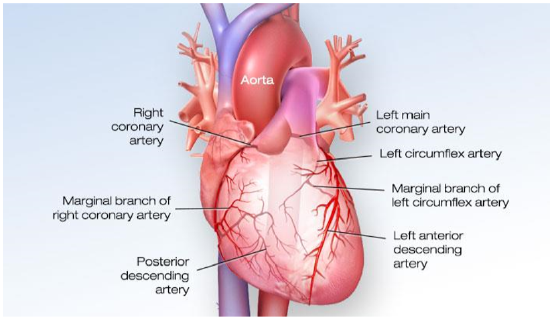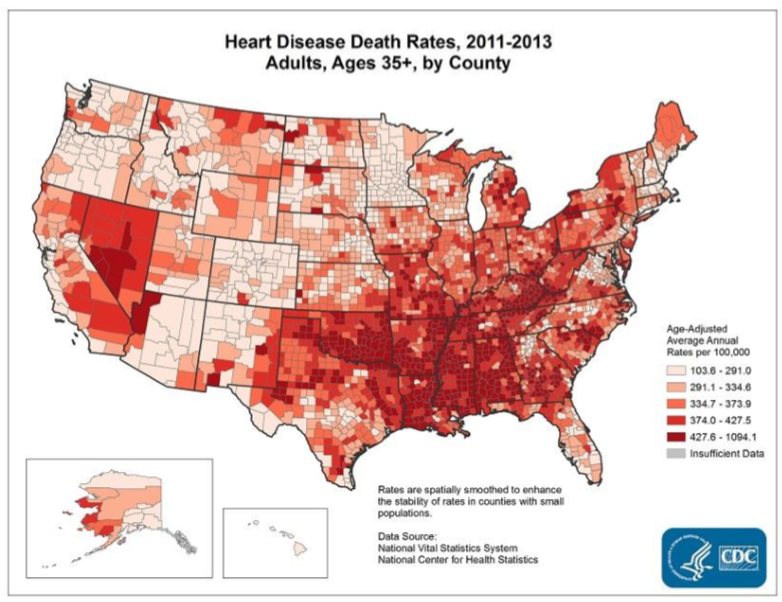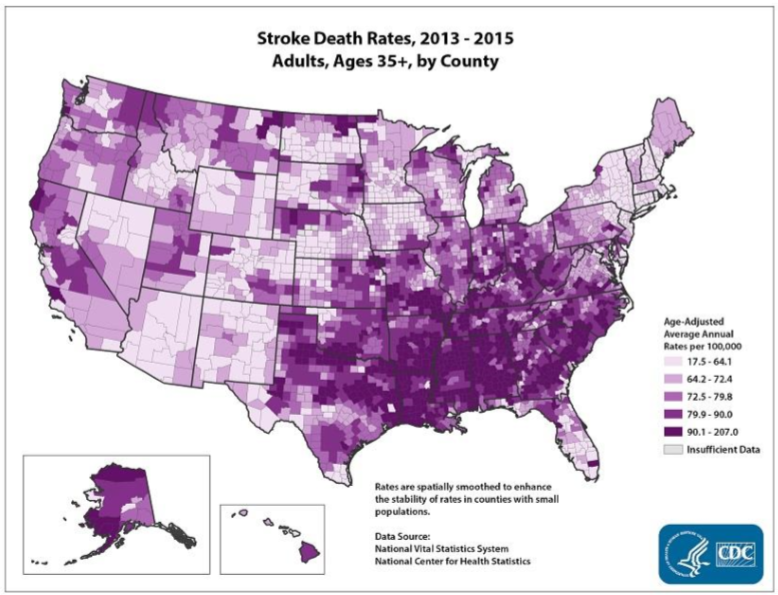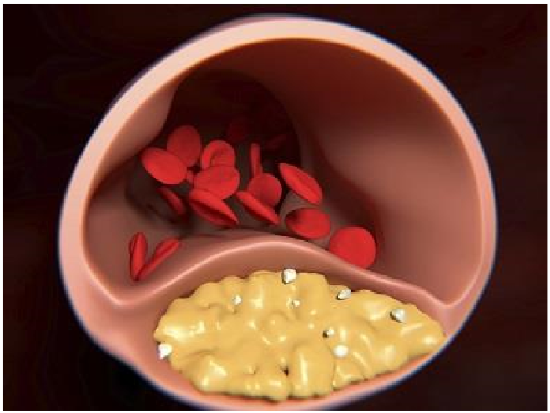Cardiovascular disease (CVD) is a class of diseases that involve the heart or blood vessels. Cardiovascular disease includes coronary artery diseases (CAD) such as angina and myocardial infarction (commonly known as a heart attack). Other CVDs include stroke, heart failure, hypertensive heart disease, rheumatic heart disease, cardiomyopathy, heart arrhythmia, congenital heart disease, valvular heart disease, carditis, aortic aneurysms, peripheral artery disease, thromboembolic disease, and venous thrombosis.
The underlying mechanisms vary depending on the disease. Coronary artery disease, stroke, and peripheral artery disease involve atherosclerosis, which is the narrowing of the inside of an artery due to the build up of plaque. This may be caused by high blood pressure, smoking, diabetes, lack of exercise, obesity, high blood cholesterol, poor diet, and excessive alcohol consumption, among others. High blood pressure results in 13% of CVD deaths, while tobacco results in 9%, diabetes 6%, lack of exercise 6% and obesity 5%. Rheumatic heart disease may follow untreated strep throat. It is estimated that 90% of CVD is preventable.
Coronary heart disease (CHD), also commonly referred to as just heart disease, is a common term for the buildup of plaque in the heart’s arteries that could lead to heart attack. But is there a difference between coronary heart disease and coronary artery disease? The short answer is often no — health professionals frequently use the terms interchangeably. However, coronary heart disease, or CHD, is actually a result of coronary artery disease, or CAD. With coronary artery disease, plaque first grows within the walls of the coronary arteries until the blood flow to the heart’s muscle is limited. View an illustration of coronary arteries below:

Figure \(\PageIndex{1}\) Coronary Arteries
The Coronary Arteries are the blood vessels that supply blood to your heart. They branch off of the aorta at its base. The right coronary artery, the left main coronary, the left anterior descending, and the left circumflex artery, are the four major coronary arteries. Blockage of these arteries is a common cause of angina, heart disease, heart attacks and heart failure.
This restriction of the blood supply to the tissues is also called ischemia. It may be chronic, narrowing of the coronary artery over time and limiting of the blood supply to part of the muscle. Or it can be acute, resulting from a sudden rupture of a plaque and formation of a thrombus or blood clot.
Anatomy of the Cardiovascular System
To fully understand Cardiovascular Diseases, it may be helpful to understand the anatomy of the cardiovascular system. It includes the following:
- Heart: the pump, divided into four chambers (R/L atria, R/L ventricles)
- Arteries: large vessels carrying oxygen-rich blood away from heart; have thick, muscular wall
- Arterioles: smaller arteries o Capillaries: smallest vessels where gas exchange takes place, oxygen is delivered to tissues and carbon dioxide is carried away
- Veinuoles: smallest veins, which carry carbon dioxide-rich blood, back to heart
- Veins: biggest vessels that carry carbon dioxide-rich blood back to heart; have one-way valves to prevent gravity from pulling blood backward (away from heart)
- Atria: the collecting chambers of the heart, located on top
- Ventricles: the pumping chambers of the heart, located on the bottom
- Aorta: the largest vessel (artery) in the body; all arteries branch from it
The right side of the heart (right atrium and right ventricle) takes CO2-rich blood and sends it to the lungs for oxygenation. The left side of the heart (left atrium and ventricle) takes O2-rich blood and delivers it to the body. The right side is said to be responsible for pulmonary circulation; the left side is said to be responsible for systemic circulation. Because of the distances involved, pulmonary circulation is a relatively low-pressure system, while systemic circulation is a relatively high-pressure system. In fact, when we measure blood pressure we’re measuring systemic pressure.
Heart Disease and Stroke Facts
Heart Disease Facts
- Heart disease is the leading cause of death for both men and women.
- About 610,000 Americans die from heart disease each year—that’s 1 in every 4 deaths.
- Coronary heart disease is the most common type of heart disease, killing about 365,000 people in 2014.
- In the United States, someone has a heart attack every 42 seconds. Each minute, someone in the United States dies from a heart disease-related event.
- Heart disease is the leading cause of death for people of most racial/ethnic groups in the United States, including African Americans, Hispanics, and whites. For Asian Americans or Pacific Islanders and American Indians or Alaska Natives, heart disease is second only to cancer.
- Heart disease costs the United States about $207 billion each year. This total includes the cost of health care services, medications, and lost productivity.
Risk Factors
High blood pressure, high LDL cholesterol, and smoking are key risk factors for heart disease. About half of Americans (49%) have at least one of these three risk factors. Several other medical conditions and lifestyle choices can also put people at a higher risk for heart disease, including:
- Diabetes
- Overweight and obesity
- Poor diet
- Physical inactivity
- Excessive alcohol use

Figure \(\PageIndex{2}\) Heart Disease Death Rates
Stroke Facts
- Stroke is the fifth leading cause of death in the United States, killing more than 130,000 Americans each year—that’s 1 of every 20 deaths.
- A stroke, sometimes called a brain attack, occurs when a clot blocks the blood supply to the brain or when a blood vessel in the brain bursts.
- Someone in the United States has a stroke every 40 seconds. Every four minutes, someone dies of stroke.
- Every year, about 795,000 people in the United States have a stroke. About 610,000 of these are first or new strokes; 185,000 are recurrent strokes.
- Stroke is an important cause of disability. Stroke reduces mobility in more than half of stroke survivors age 65 and over.
- Stroke costs the nation $33 billion annually, including the cost of health care services, medications, and lost productivity.
- You can’t control some stroke risk factors, like heredity, age, gender, and ethnicity. Some medical conditions—including high blood pressure, high cholesterol, heart disease, diabetes, overweight or obesity, and previous stroke or transient ischemic attack (TIA)—can also raise your stroke risk. Avoiding smoking and drinking too much alcohol, eating a balanced diet, and getting exercise are all choices you can make to reduce your risk.
Common Stroke Warning Signs and Symptoms
- Sudden numbness or weakness of the face, arm, or leg—especially on one side of the body.
- Sudden confusion, trouble speaking or understanding.
- Sudden trouble seeing in one or both eyes.
- Sudden trouble walking, dizziness, loss of balance or coordination.
- Sudden severe headache with no known cause.

Figure \(\PageIndex{3}\). Stroke Death Rates
Coronary Artery Disease (CAD)
Coronary artery disease (CAD) is the most common type of heart disease in the United States. For some people, the first sign of CAD is a heart attack. Therefore, taking steps to reduce your risk for CAD is essential.
Research suggests that CAD (also referred to as coronary heart disease, abbreviated CHD) starts when certain factors damage the inner layers of the coronary arteries. These factors include:
- Smoking
- High levels of certain fats and cholesterol in the blood
- High blood pressure
- High levels of sugar in the blood due to insulin resistance or diabetes
Causes of CAD

Figure \(PageIndex{4}\). Plaque Buildup
When damage occurs, your body starts a healing process. The healing may cause plaque to build up where the arteries are damaged. Plaque is made up of deposits of cholesterol and other substances in the artery. This progression of plaque build up is called atherosclerosis.
The buildup of plaque in the coronary arteries may start in childhood. Over time, plaque can narrow or block some of your coronary arteries. This reduces the flow of oxygen-rich blood to your heart muscle.
Eventually, an area of plaque can rupture (break open). If this happens, blood cell fragments called platelets will stick to the site of the injury and may clump together to form blood clots. Blood clots narrow the coronary arteries even more and worsen angina (chest discomfort or pain) or cause a heart attack.
Over time, CAD can weaken the heart muscle. This may lead to heart failure, a serious condition where the heart can’t pump blood the way that it should. An irregular heartbeat, or arrhythmia, also can develop.
Coronary artery disease is the most common type of heart disease, but there are many other conditions that affect the heart:
- Acute coronary syndrome is a term that includes heart attack and unstable angina.
- Angina, a symptom of coronary artery disease, is chest pain or discomfort that occurs when the heart muscle is not getting enough blood. Angina may feel like pressure or a squeezing pain in the chest. The pain also may occur in the shoulders, arms, neck, jaw, or back. It may feel like indigestion. There are two forms of angina—stable or unstable:
- Stable angina happens during physical activity or under mental or emotional stress.
- Unstable angina is chest pain that occurs even while at rest, without apparent reason. This type of angina is a medical emergency.
- Aortic aneurysm and dissection are conditions that can affect the aorta, the major artery that carries blood from the heart to the body. An aneurysm is an enlargement in the aorta that can rupture or burst. A dissection is a tear in the aorta. Both of these conditions are medical emergencies.
- Arrhythmias are irregular or unusually fast or slow heartbeats. Arrhythmias can be serious. One example is called ventricular fibrillation. This type of arrhythmia causes an abnormal heart rhythm that leads to death unless treated right away with an electrical shock to the heart (called defibrillation). Other arrhythmias are less severe but can develop into more serious conditions, such as atrial fibrillation, which can cause a stroke.
- Atherosclerosis occurs when plaque builds up in the arteries that supply blood to the heart (called coronary arteries). Plaque is made up of cholesterol deposits. Plaque buildup causes arteries to narrow over time.
- Atrial fibrillation is a type of arrhythmia that can cause rapid, irregular beating of the heart’s upper chambers. Blood may pool and clot inside the heart, increasing the risk for heart attack and stroke.
- Cardiomyopathy occurs when the heart muscle becomes enlarged or stiff. This can lead to inadequate heart pumping (or weak heart pump) or other problems. Cardiomyopathy has many causes, including family history of the disease, prior heart attacks, uncontrolled high blood pressure, and viral or bacterial infections.
- Congenital heart defects are problems with the heart that are present at birth. They are the most common type of major birth defect. Examples include abnormal heart valves or holes in the heart’s walls that divide the heart’s chambers. Congenital heart defects range from minor to severe.
- Heart failure is often called congestive heart failure because of fluid buildup in the lungs, liver, gastrointestinal tract, and the arms and legs. Heart failure is a serious condition that occurs when the heart can’t pump enough blood to meet the body’s needs. It does not mean that the heart has stopped but that muscle is too weak to pump enough blood. The majority of heart failure cases are chronic, or long-term heart failures.
- The only cure for heart failure is a heart transplant. However, heart failure can be managed with medications or medical procedures.
- Peripheral arterial disease (PAD) occurs when the arteries that supply blood to the arms and legs (the periphery) become narrow or stiff. PAD usually results from atherosclerosis, the buildup of plaque and narrowing of the arteries. With this condition, blood flow and oxygen to the arm and leg muscles are low or even fully blocked. Signs and symptoms include leg pain, numbness, and swelling in the ankles and feet.
- Rheumatic heart disease is damage to the heart valves caused by a bacterial (streptococcal) infection called rheumatic fever.
Risk Factors for Coronary Heart Disease
Coronary heart disease risk factors are conditions or habits that raise your risk of coronary heart disease (CHD) and heart attack. These risk factors also increase the chance that existing CHD will worsen.
There are many known CHD risk factors. You can control some risk factors, but not others.
Risk factors you can control include:
- High blood cholesterol and triglyceride levels (a type of fat found in the blood)
- High blood pressure
- Diabetes and prediabetes
- Overweight and obesity
- Smoking
- Lack of physical activity
- Unhealthy diet
- Stress
The risk factors you can't control are age, gender, and family history of CHD.
Many people have at least one CHD risk factor. Your risk of CHD and heart attack increases with the number of risk factors you have and their severity. Also, some risk factors put you at greater risk of CHD and heart attack than others. Examples of these risk factors include smoking and diabetes. Many risk factors for coronary heart disease start during childhood. This is even more common now because many children are overweight and don’t get enough physical activity. Researchers continue to study and learn more about CHD risk factors.


